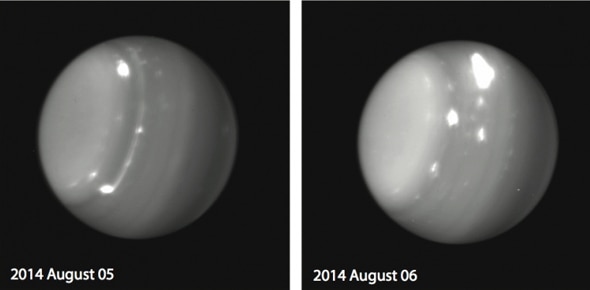Create a free profile to get unlimited access to exclusive videos, sweepstakes, and more!
Massive Storms Erupting on Uranus

Yes, I know. Let’s get this out of the way immediately.
But it’s true: Some huge storms have formed on Uranus, so big they’re easily visible to large telescopes on Earth.
Storms on the biggest planets in our solar system are peculiar. Some are generated internally by planetary dynamics, like Jupiter’s Great Red Spot. Others are seasonal, like the ridiculously enormous storm that boiled to the cloud tops of Saturn in 2010 and got so big it wrapped all the way around the planet. Big storms on Saturn tend to erupt in the hemisphere where it’s summer.
Uranus is weirder yet. Seasons on a planet are due to its axial tilt (which astronomers call “obliquity” to be all fancy). For example, the Earth is tilted by about 24°, and when the Northern Hemisphere is tipped toward the Sun it’s summer there, and when it’s tipped away it’s winter.
For reasons still being argued over, Uranus has an extreme tilt: It’s actually sideways, with a 98° obliquity. That means that the south pole, for example, will see no sunlight at all for half the Uranian year (which lasts 84 Earth years), then will get direct sunlight for a long time as well; at the height of summer the Sun will be close to overhead.
When Voyager 2 flew past the planet in 1986 there wasn’t a lot of weather to be seen. That may have just been bad timing, a pass when things were calm on the seventh planet. Over the years telescopes here on Earth have gotten bigger and better, and our cameras have as well. Now we have astronomers observing the outer planets pretty often, and can see quite a bit of detail. And they’re seeing storms.
The images above show Uranus as it was seen on Aug. 5 and 6, 2014, using the monster 10-meter Keck infrared telescope in Hawaii. The atmosphere of Uranus has a lot of methane in it, which strongly absorbs red light, making the planet look blue-green. The storms we’re seeing may be dredging up methane ice above the absorbing layers, so they look very bright in the infrared.
My friend, the astronomer Heidi Hammel, is on the team observing Uranus, and on her Facebook page she said that there is a Hubble observing proposal that will be triggered if amateur astronomers can spot this storm. Given that it’s the brightest to be seen in modern times, it’s entirely possible this is visible to smaller ‘scopes. Right now Uranus is well-placed for viewing late at night for Northern Hemisphere observers (on Earth, to be clear). I know a lot of advanced amateur astronomers read my blog, so if you can get a glimpse of this storm, let Heidi know on Facebook!
Post script: In my opinion, there has only been one honestly funny joke about the pronunciation of Uranus, and it was done on Futurama.


























